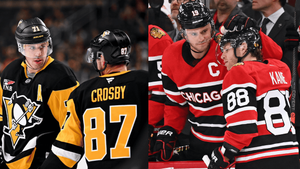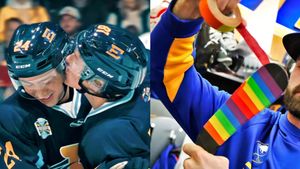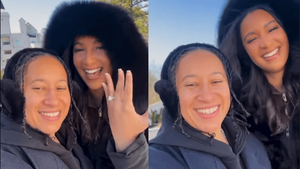He is one of the most prominent LGBT businessmen in the apparel industry, but you won't find him in a suit. Entering his Western-themed office on Battery Street in San Francisco, arguably not the fashion hub of the United States, you will find a dapper but decidedly relaxed executive sitting at an aged wood table -- part of the casual Western motif of his office -- and clad in jeans. As president of Levi Strauss & Co.'s Levi's Brand Division, Robert Hanson has been tasked with revitalizing the over a century-old brand, and he knows that the LGBT market is a key component in doing that. When he moved back to the United States from a position with the company in Europe in 2001, the denim market was saturated, and Levi's was having problems both with its product and with its distribution and marketing. Hanson has done a lot of things to help turn this around, but he knew from the beginning that LGBT consumers were going to be instrumental in making the brand cool again. In 2007 the company launched a new gay-specific television advertisement in which two men ended up together, which sparked buzz not only among gays but in the advertising world as well. But this was just the beginning. Levi's was the sole sponsor of October's premiere of Milk at the Castro Theatre and the after-party at San Francisco City Hall. On the day of the premiere, The Advocate sat down with Hanson to talk about how he helped make Levi's hot again and what the company plans to do to continue to get the gays.
Why did Levi's decide to sponsor the premiere of Milk in San Francisco? Number 1, I think we're really honored to be the sole sponsor of the premiere of the Milk film. I think it's primarily rooted in the fact that if you look at who Harvey Milk was and what he stood for from a values standpoint, he was an original. He had courage. He had integrity. Those are values that I think are importantly associated with the Levi's brand. On a more logical level, Danny Glicker, the stylist for the film, went back and looked at The Times of Harvey Milk, and there's no question that in the '70s, when Milk was at the pinnacle of his impact, he and those around him wore, as a part of their uniform, the original 501 button-fly jeans. So if you look at the film, at the core of the wardrobe you see the Levi's 501 jean, you see the Levi's 505 jean, which is our straight-fit, you see the Levi's trucker jacket. Those are all a part of the uniform of that time. And the final point is we've been working to deepen our engagement with the LGBT community. I think we've been targeting progressive gay and lesbian people in particular because this is a group of people who we have an authentic relationship with, we've done great work with, and frankly, they've been great advocates for the brand for a long time. We're also opening a store in the Castro quite close to where Harvey's camera store was. So there's just serendipity with all of it coming together.
Well, the jean was a sign of rebellion. When Milk first started getting involved in politics he wasn't wearing a suit. He was wearing jeans, and people told him he needed to dress more appropriately and walk the walk. Do you think that feeling of rebellion has stayed with the brand, or are jeans just part of the suit now? I would say yes, it stayed with the brand. Rebellion manifests itself differently with every generation, and if you talk to younger people today, the sense of aggressive rebelliousness, like you're fighting against something, isn't what young people would say they feel. I think they feel they are fighting for something. So I think there's a sense of independent-mindedness or an independent spirit that is associated with the Levi's 501 jean that certainly was associated with Harvey Milk and is still associated with our jeans.
Did you personally identify this film as something you wanted to get involved with? How did your partnership come about? Sort of organically. We knew all of this was happening because we made ourselves available to Danny Glicker to help wardrobe the film. But we didn't actively seek a sponsorship role or any sort of funded relationship. It was just "Look, it's authentic, it makes sense; how can we help?"
You also sponsored the Out 100 event in New York and have started advertising with the LGBT community again. Why now? Let me put it in a broader perspective because it's important for people to understand. Levi Strauss & Co. has always had a rich and honorable history in working on frontier issues, issues that are oftentimes related to social justice. If I look outside of the LGBT community, to just give you a really poignant example, we integrated our production facilities in the United States 20 years before the Civil Rights Act of 1964. So we were working on behalf of the African-American community all the way back then before it was popular to do so. So it demonstrates the company's commitment to social sustainability and social justice. We were the first Fortune 500 company to focus on HIV and AIDS, and have contributed $35 million since the virus became a problem. We were the first Fortune 500 company to extend health benefits to the domestic partners of our unmarried employees. We were the only company in California to sign on to the brief arguing the business case for nondiscrimination in California's marriage statutes, which have now been joined by other great companies like PG&E and AT&T, Viacom. We supported the No on Proposition 8 effort because we fundamentally believe that limiting access to the world's best talent pool by saying that it's acceptable to write discrimination into the legislation of the state is not only socially unjust but it just doesn't make business sense. That's another example. We were one of the only companies to partner with Out and Equal and others to support the [federal] Employment Non-Discrimination Act, and so on and so on. There's a lot of work we've always done on behalf of the community.
How long have you been with the company? I've been with the company for 20 years, so a lot of this is during my time. I won't take any credit for driving any of it. But as an officer of the company, I always understand and advocate the advancement of all the issues that we focus on. It's only recently that we've reengaged in a really thoughtful marketing relationship with the LGBT community, because as we've gotten back to profitable revenue growth and share growth, we've put better products in the market and better distribution. We diversified our distribution base and we're selling in more places that the LGBT community would be shopping in. We feel it's no longer about a buy-sell transactional relationship; it's really about how engaged are you with these communities.
Levi's brought you back from Europe to revitalize the brand. I moved myself back here, happily [laughter]. But yeah, I came back from Europe -- I was the president of Levi's Europe from 1998 to 2001 -- and I came back in 2001.
So you started in San Francisco originally? Yeah, I started here in '88. I was actually an assistant advertising manager in our youth floor division. I worked my way through to be the director of marketing there. I worked on the Dockers brand from '92 to '98 in new business development. I worked on the Dockers golf in women's and young men's business as well as ran all the marketing for Dockers, including the "Nice Pants" marketing campaign.
And were you out this whole time? Yes. Always have been, always chose to be.
How old were you when you started in '88? I was ... ah, very tricky, very clever ... how old was I? I was 25.
OK, aside from sponsoring Milk, how did you get the gay community back on board with the brand? Fundamentally, it's all about great product. I think before, we didn't have good enough product. Now we do. Then the next step was to rebuild our relationships with great customers like Barneys, Urban Outfitters, Macy's, and others, so that our brand was more widely available with premium distribution where the LGBT community shops. The next step from there really was about developing our own store network because a lot of the LGBT community shops in vertical specialty, and we didn't have a very big network of our own stores. The final bit, which we're just getting to now, is getting the marketing relationship rebuilt. So it's a very methodical approach. It took a little bit longer then I would have wanted, which I'm pretty dissatisfied and impatient with, but I think what we've been able to demonstrate, given that we're seeing nice share growth in both men's and women's, is that the strategies are working. They're leading to a fundamental recovery and leadership position for the Levi brand. I think the marketing engagement work that we're doing, like the work that we're doing on the Milk film, is a great example of how we'll do that. Not only with the LGBT community but with the Latino community, the African-American community, and more progressive consumers across a number of constituencies in the states.
Do you think you'd be doing all of this work with the gay community if you weren't with this company? I think the company would be doing it, certainly. Because the track record that we have of engaging thoughtfully with the LGBT community goes well beyond my tenure as a senior leader within the company.
So you didn't have to come in and say, "I really think we need to focus on this community"? The brand had already decided this was important? I give all the credit to my team. It's the team who is very maniacally focused on the consumer, and they're the ones that have crafted the majority of the strategies that are working now and are deepening our relationships. Now, obviously, I understand, coming from the position I come from as an out gay leader, I understand what it's like to be part of a subculture. I get that. But where I might have in the past more self-identified as an out gay leader, I think what I self-identify now as is a leader who's at the table who contributes to the company and [happens to be] gay. I just think it's important, because you evolve. I meet people all of the time who I think are more talented and more capable then I am but maybe not as fearless. But if I can be a person who is fearlessly getting to the table and employing my skills, it creates a pathway for others to come after me who have an opportunity that perhaps wouldn't be available to them.
I just want to talk about that Levi's campaign you did where a man was on the phone and in one version a hot girl in a phone booth burst through the floor of his apartment and in another a hot guy does the same. That was a pretty bold leap in the LGBT marketplace. Where did that come from, and were you scared about it or did you think you had correctly read the marketplace? Never scared, because I think Levi Strauss & Co. has had a long history in working on issues that are closely associated with social justice. So we just believe fundamentally that it's the right thing to do, and we believe in the philosophy of "profits are principles." This idea was gotten to in a really simple way. We said, "Who are the consumer segments that we should have the better and deeper relationship with? The LGBT community is one of them," and then our creative teams both internally and at another agency at the time came together and said, "Look we've got this great film," and it would be really easy, which isn't typical, because it just had an ending where you could flip it, where you could shoot it in two ways and air it in broad, mass communications with the traditional male-female ending and air it in more targeted communication, with still massive reach but more targeted, that would have a broader appeal to the LGBT community in particular and show the male-male ending. It was just the right thing to do. And yet we did get a lot of credit, which I give to the team for putting it on more broadly viewed cable networks. We ran on programming like Project Runway, for example. We made those kinds of decisions versus just putting it on Logo, where we obviously ran it as well. You know, it's step by step by step. We've had a long and rich relationship with gay and lesbian people. We appreciate it, and obviously you know all the facts. The market is worth a lot, so it does come down to business for us. But there's an authentic relationship that I think binds the community and the brand together.




































































Charlie Kirk DID say stoning gay people was the 'perfect law' — and these other heinous quotes